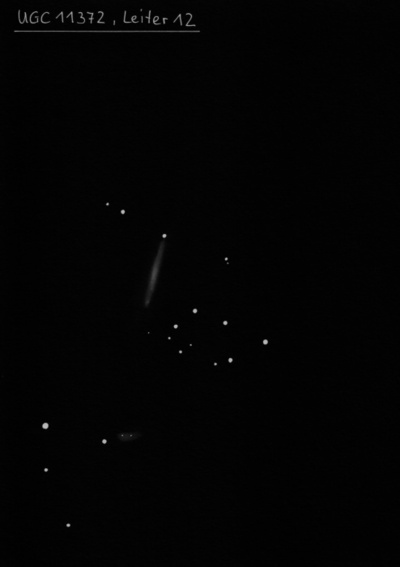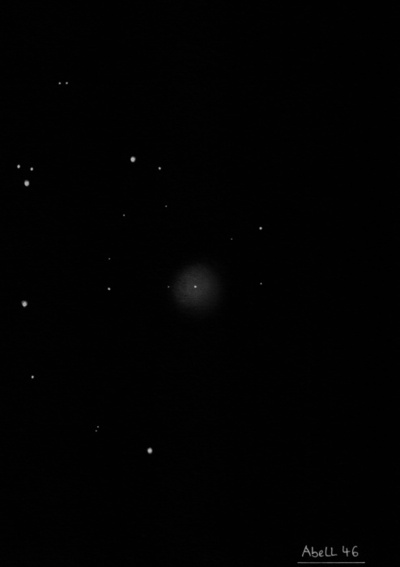Lyra is a typical, distinctive constellation of the northern summer sky, located on the edge of the Milky Way, between Hercules and the Cygnus, small but all the more interesting. The constellation is quite rich in interesting and pretty objects, especially for larger telescopes. The Ring Nebula - M57 - is a typical example of planetary nebulae. The star Sheliak is a representative of the group of occulting variable stars and the star ε Lyra is again one of the most observed multiple stars ever. Also attractive binaries for small telescopes are δ and ζ Lyra. At the junction of δ1 and δ2 Lyra, you may miss the inconspicuous open cluster Stephenson 1. It is made up of a loose cluster of 15 stars that can be observed in binoculars. It is one of our closest open clusters, so it is part of the spiral arm of Orion. For larger telescopes, NGC 6791 is again a beautiful open cluster and a chance to observe several galaxies.
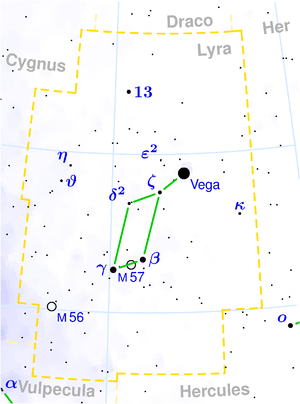
Vega (α Lyr) - Thanks to this star, the constellation is unmistakable, as the bluish Vega is the fifth brightest star in the sky (0.04 mag). Together with the stars Deneb in Cygnus and Altair in Aquila, Vega forms the Summer Triangle. Its distance from Earth is estimated to be 25 light-years, and it outshines our Sun by a factor of 40, with an absolute magnitude of +0.5. Two faint companions do not form part of the physical system.
Sheliak (β Lyr) - It is a representative of eclipsing variable stars of the beta Lyrae type. Both stars orbiting each other have the shape of a rotational ellipsoid. The star changes its brightness from 3.4mag to 4.4mag in a period of 12.908 days. Within the period, there is also a secondary minimum, during which the brightness decreases by 0.4mag. Suitable comparison stars are γ (3.25mag) and κ LYR (4.33mag).
R Lyrae - The conspicuously reddish-orange star visible to the naked eye is a semi-regular variable star, whose brightness varies in the range from 3.8mag to 5mag approximately every 46 days.
δ Lyr - Easily observable optical double star with a separation of 620", one component of which is distinctly reddish (with slightly variable brightness ranging from 4.3m to 4.4mag) and the other is pale blue (5.5mag). They can be resolved with a hand lens.
ε Lyrae - "Double double", a multiple system near Vega, in which we can distinguish two components with the naked eye. In a telescope, these components are clearly distinguishable, with magnitudes of 5.1 and 5.4 at a separation of 208". When observed with a telescope of at least 60mm aperture and higher magnification, they split into double stars (companions ε1 with magnitude 6.5 and ε2 with magnitude 5.3). The mutual separation of one pair is 2.6", and the other pair is 2.3", with orbital periods determined to be 1,166 and 585 years. They are located at distances of 162 light-years and 156 light-years.
RR Lyrae - This star, located on the border with Cygnus, is not visible to the naked eye and represents a significant class of variable stars whose brightness changes in a short period. These are old stars mainly found near the galactic center and in globular clusters, the oldest formations of the galaxy. RR Lyrae pulsates regularly, similar to delta Cephei, but its period is shorter than one day - 0.567 days. During this time - 13 hours and 36 minutes, the apparent brightness fluctuates from 7mag to 8.1mag. The cycle can therefore be observed (from some areas) practically in one night. It is white at maximum and takes on a yellowish hue at minimum.
Struve 2470/2474 - Another double double star in the constellation, observed northeast of γ Lyrae. The two main stars are separated by just over 10 arcminutes. In at least a 10 cm telescope, Struve 2470 splits into two stars, which are separated by 13.4 arcseconds: a white and a light blue star, with magnitudes of 6.6 and 8.6, respectively. The faint yellow components of Struve 2474 are separated by 16.2 arcseconds and have magnitudes of 6.7 and 8.8.
M 57
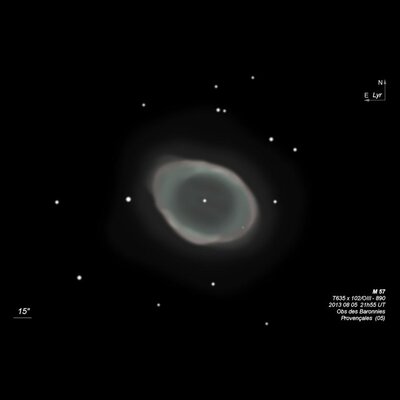
15x50mm IS binoculars (6/19/09): fairly faint but clearly non-stellar, appearing as a very small but definite disc.
Antoine Darquier discovered M57 = NGC 6720 = h2023 using a 2.5-inch refractor in early 1779. He wrote, "nebula between Gamma and Beta of Lyra; it is pretty dull, but perfectly outlined; it is as large as Jupiter and resembles a fading planet." This description perhaps inspired the name "planetary nebula". It has been assumed the Darquier's discovery preceded Messier's independent discovery, but Don Olson and Giovanni Maria Caglier reported in the June 2017 issue of Sky & Tel, that Messier definitely observed the Ring Nebula on 31 Jan 1779 while searching in the region of Bode's comet. Darquier wasn't even aware of Bode's comet until at least 9 Feb, so Messier deserves discovery credit. In any case, M57 was the second PN discovered, after M27 in 1764.
In 1785 William Herschel logged, "A perforated Nebula, or Ring of Stars. Among the curiosities of the heavens should be placed a nebula, that has a regular, concentric, dark spot in the middle, and is probably a Ring of stars. It is of an oval shape, the shorter axis being to the longer as about 83 to 100; so that, if the stars form a circle, its inclination to a line drawn from the sun to the center of this nebula must be about 56 degrees. The light is of the resolvable kind [i.e., mottled], and in the northern side three very faint stars may be seen, as also one or two in the southern part. The vertices of the longer axis seem less bright and not so well defined as the rest. There are several small stars very near, but none seems to belong to it."
The discovery of the challenging central star (V = 15.7 according to http://arXiv.org/abs/astro-ph/0611543) is generally attributed to Friedrich von Hahn in 1795 using a 12" f/20 reflector (mirror from William Herschel). Though he subsequently reported the "small star is no longer visible", I find his original observation unlikely as his telescope was probably equivalent to a modern 8" or 9" reflector. William and John Herschel never reported seeing the central star, nor Lord Rosse in his 36-inch. Apparently it was missed by Trouvelot with the Harvard 18" and Holdenwiththe Washington 26" refractor. Rosse found the central star "pretty bright" with the 72-inch (first seen in 1848) and William Lassell sketched the central star with his 48" in 1860 (unpublished). Father Secchi claimed an interior star was seen with the 9.5" refractor in Rome around 1865. A second interior star was observed through the Lick 36-inch refractorand one at the end of the major axis.
The 1936 Carnegie Institute Yearbook mentions that a photograph made with the Mt. Wilson 100-inch by Duncan revealed a "faint, hitherto unrecorded envelope, roughly circular in outline and about twice the diameter of the well-known ring." Soon afterwards, a larger outer envelope was found in NGC 6826.
100/150mm - 6" (7/78): first view in a dark sky (Bryce Canyon), high surface brightness, ring-shape obvious, easily takes high power, slightly elongated. Visible in 8x50 finder as a faint "star".
300/350mm - 13" very bright, moderately large, slightly elongated WSW-ENE, high surface brightness, best example of annularity although interior not dark. Slightly fainter at ends of major axis. Central star not seen.
400/500mm - 17.5" (6/5/99): Viewed under very steady seeing at 380x. The halo was elongated 4:3 WSW-ENE and clearly brighter along the north and south sides (minor axis). The ends of the major axis were clearly "thinner" and slightly fainter at the following end. The interior had a pale gauzy appearance. The edge of the ring has a "wooly" appearance with a strong impression of small irregular wisps or filaments hinting at the extremely faint outer halo. The central star popped in and out of view a few times. A mag 13 star is close off the east side and a very faint mag 15.7 star is a similar distance off the west end. Another mag 15.6 star is 1' due south of center. At high power a 3" pair of mag 14-15 stars ~1.3' NNW of center were just resolved with a difficult mag 16.1 star ~30" further north.
17.5" (7/1/89): extremely faint central star visible for moments at 412x just east of center. The central star was held steadily for a few seconds at best with averted vision. Forms an unusual pair with the extremely faint galaxy IC 1296 4' NW.
600/800mm - 24" (5/25/14): observed M57 at 1000x (4.5mm Delos + 2x Powermate) in excellent seeing. The Ring itself was stunning with mottling, textured surface, and brightness variations across the ring clearly visible. The central star was very faint, but visible ~75% of the time (sometimes as a quasi-stellar brightening). Often, though, it was seen as a sharp stellar point. Overall, this was certainly one of the finest views of the Ring I've experienced.
900/1200mm - 48" (10/24/11): at 488x and 610x the central star was easily visible continuously in fair seeing. Using 287x and an NPB filter, a much fainter large outer halo was easily visible surrounding the main bright ring (86"x63"). It appeared much more circular than the ring and ~2.5' diameter (roughly doubling the size), so appeared to extended further out in the direction of the ring's minor axis. This outer shell was surprisingly evident and even displayed a slightly ragged or irregular edge.
Notes by Steve Gottlieb
M 56
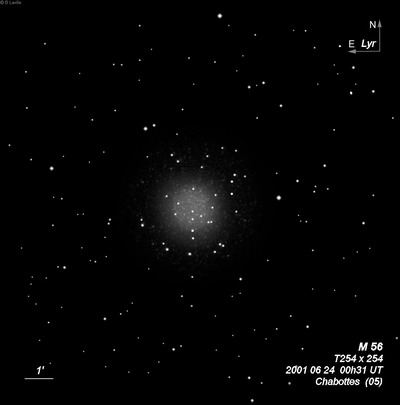
80mm (8/27/87): easily visible at 11x.
Charles Messier discovered M56 = NGC 6779 = h2036 on 19 Jan 1779 and described a "nebula without stars, having little light." Caroline Herschel independently found the cluster on 7 Apr 1783. WH first observed the cluster on 31 May 1783 with his 8-inch and noted it was "all resolved into stars [at high power]." On 17 Jul 1784 (sweep 239), he recorded "a cl of v compressed stars, nearly R, and about 4' in dia, very accumulated in the middle; L, r." JH made a number of observations and on 1 Aug 1829 (sweep 198) recorded a "Fine compressed cluster; R, inclining to a triangular form; bM; stars 12...14m. A fine object, diam 3'." Observing with an 11-inch refractor, Heinrich d'Arrest wrote "a star cluster, which contains a large number of stars, none of which is brighter than 12 to 13th magnitude. With 356x resolved into minute stars." R.J. Mitchell, LdR's assistant on 12 Aug 1855, logged "fine cluster, R, centre much compressed; composed of from 10 to 15 st of 13m and many much fainter ones. A few scattered stars have appearance of rays from the centre."
200/250mm - 8" (10/4/80): very grainy, ragged, few faint stars resolved.
300/350mm - 13.1" (5/26/84): many faint stars and some brighter stars near the west edge.
13.1" (8/16/82): a number of faint stars resolved, particularly at the west edge.
400/500mm - 17.5" (8/27/87): about 30 stars resolved including many mag 15 stars at 280x. Resolution is evident over the entire disc and at the edges of the ill-defined halo. Situated in a rich star field.
600/800mm - 24" (8/12/15): superb view at 564x (10mm ZAO + 2.5x Powermate) in excellent seeing and transparency. This bright globular was highly resolved over the entire large central region and within a straggling, irregular halo that filled the 5' field. Roughly 100 or more stars were resolved, though it was difficult to judge the extent of the halo as it thinned into the density of the surrounding Milky Way star field. The unresolved background glow of the halo was more evident on the south side.
Notes by Steve Gottlieb
NGC 6765
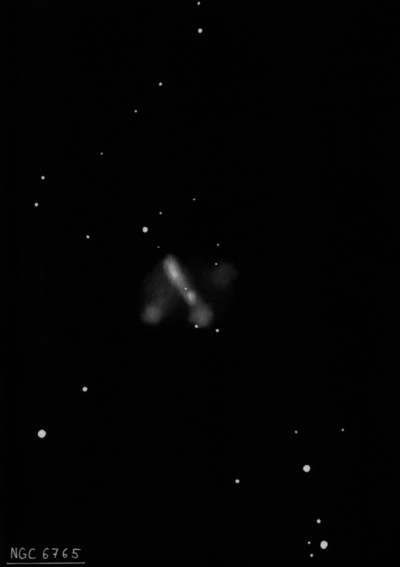
Albert Marth discovered NGC 6765 = m 398 = Sf 42 = St II-27 on 28 Jun 1864 with Lassell's 48-inch on Malta and noted "F, S, mE or ray." His position is accurate. Truman Safford independently rediscovered this object on 12 Jul 1866 using the 18.5-inch Clark refractor at Dearborn Observatory in Chicago (he also found the planetary NGC 6842 in Vulpecula the same night!) and again by Édouard Stephan on 20 Jul 1870 with the 31-inch reflector at Marseilles. Dreyer credited Stephan with the discovery in the GC Supplement (GCS 5941), but both Marth and Stephan are listed in the NGC. Minkowski entered it as the 68th object in his first discovery list (M 1-68) of "New Emission Nebulae" (1946), based on objective prism plates taken with the 10-inch Bruce Astrograph at Mount Wilson, and missed the equivalence with NGC 6765.
300/350mm - 13" (6/18/85): faint, elongated SSW-NNE, appears similar to a diffuse galaxy. A faint mag 14.5 star is at the NE tip. Located 20' NW of ∑2483 = 7.9/9.0 at 10".
400/500mm - 17.5" (9/5/99): picked up at 100x as a small, irregular glow in a rich star field by moving 20' NW of ∑2483 = 7.9/9.0 at 10". At 220x, the PN is clearly elongated ~2:1 SW-NE. The appearance is odd with a much brighter NE end and a fainter extension to the SW end. A mag 14.5-15 star is just off the NE end in the direction of the elongation. At 380x, a very faint star was intermittently glimpsed within the NE end. If this is the central star it is very eccentrically placed.
Notes by Steve Gottlieb
NGC 6791
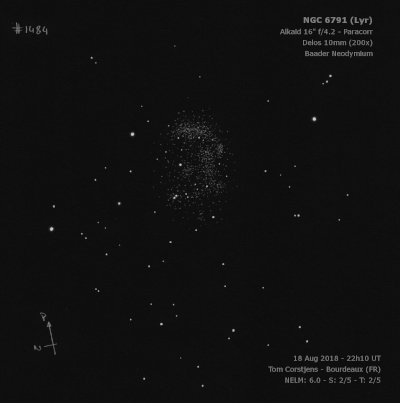
NGC 6791 is one of the very oldest open clusters, along with Berkeley 17, with an age of 8 to 10 Gyr!
Friedrich August Winnecke discovered NGC 6791 = Au 45 in December 1853 with his 2.8-inch Merz refractor. At the time he was an 18-year old astronomy student at Gottingen University. He described the cluster (repeated in Auwers' 1862 list of new nebulae) as "very faint; a miniature image of M74", so the cluster was clearly not resolved. But at Königsberg, Auwers noted that it consisted of many mag 12 stars that appeared nebulous in smaller instruments. Horace Tuttle independently discovered the cluster on 17 Jul 1859 with a 10-cm comet-seeker at Harvard College observatory (announced in AN 1453).
200/250mm - 8" (9/11/82): moderately large, very faint hazy patch like a low surface brightness galaxy, no resolution.
300/350mm - 13.1" (9/11/82): fairly faint, moderately large, many faint stars are resolved over haze with averted, low surface brightness.
600/800mm - 24" (8/12/15): gorgeous field at 200x (1/2°) using a 13mm Ethos, but this rich cluster was superbly resolved at 200x using a 10mm Zeiss Ortho. Roughly 100 stars were visible in an irregular oval outline, slightly elongated NW to SE. The stars are remarkably uniform but slightly brighter along the southeast edge. Interestingly, a large percentage of the resolved stars form the outline as the center is richer and contains more fainter stars (like a very weakly compressed globular cluster). A string of stars extends roughly through the center, bisecting the oval and a "void" is created by this string on the southeast interior. The outline is fairly well-defined, with some brighter field stars beyond, including a couple of mag 10-10.5 stars off the south side and a mag 9.5 star 11' NW of center. Excellent cluster!
Notes by Steve Gottlieb
NGC 6745
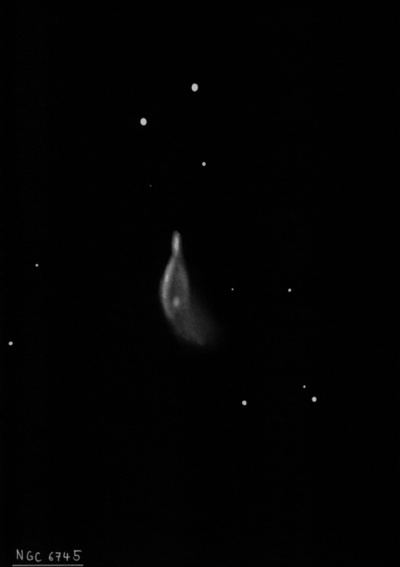
Édouard Stephan discovered NGC 6745 = St X-38 on 24 Jul 1879 and noted "vF, lE north and south." His micrometric position is accurate.
300/350mm - 13.1" (7/20/85): fairly faint, edge-on SSW-NNE. At 220x appears to bend on the NNE end to the west. This is a disrupted interacting system on the POSS and the extension seen at the NNE end may be the contact pair.
900/1200mm - 48" (10/24/11 and 10/26/19): we observed the "Bird's Head" galaxy at 488x and 610x and the same detail visible in the April observation was seen. In addition, I took notes on the detached companion (PGC 200361), which was immediately noticed just off the north edge of NGC 6745. It appeared very faint, small, elongated 3:2 N-S, ~12"x8". With averted vision it was continuously visible.
48" (4/1/11): this interacting galaxy pair or triple was a fascinating sight at 488x. The main body is bright, very asymmetric, extending 2:1 N-S, ~1.1'x0.5'. The brighter east side is noticeable curved or bulging to the east and bends on the north end towards the west. A thin strip along the eastern edge glows brighter. The western edge of the main galaxy is relatively straight and dimmer. The south end has a fairly blunt or rectangular appearance. At the north end, a very unusual bright spike or "bird's beak" with a high surface brightness juts out of the main body, perhaps 12"x4" (catalogued as NGC 6745 NED03 = PGC 200362 = KTG 69B). A very faint, very small detached glow, ~5" diameter, is just north of the "beak" (catalogued as NGC 6745 NED02 =(PGC 200361 = KTG 69C).
Notes by Steve Gottlieb
M 1-64
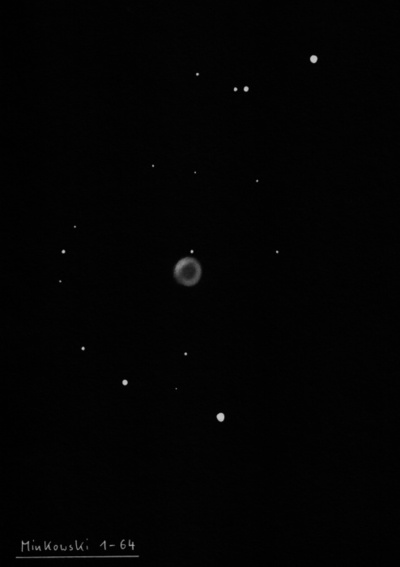
| Type | PN |
| RA | 18:50:02.1 |
| Dec | +35:14:36.0 |
| major_axis | 24.0'' |
| mag | 13.3 |
| surface_bright | 11.0 |
K 3-27
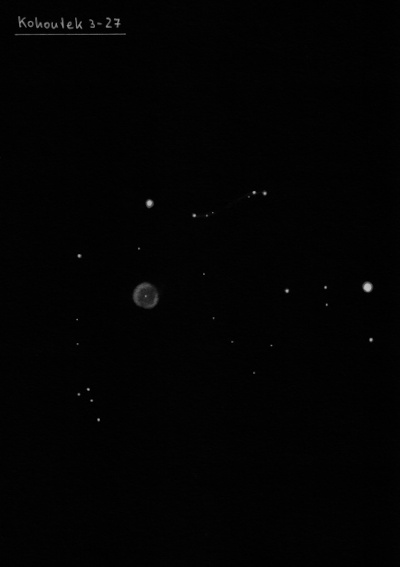
| Type | PN |
| RA | 19:14:30.0 |
| Dec | +28:40:45.0 |
| major_axis | 18.0'' |
| mag | 14.3 |
| surface_bright | 11.2 |
UGC 11195
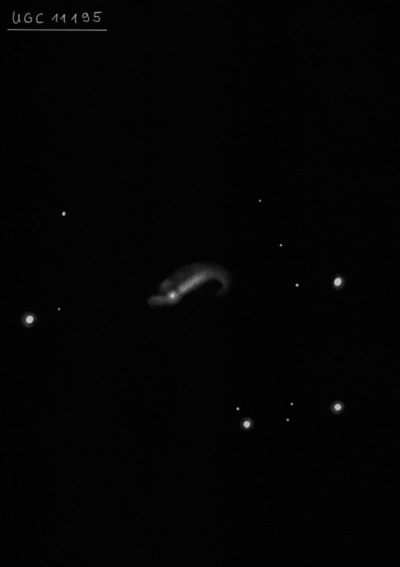
| Type | GX |
| RA | 18:17:57.0 |
| Dec | +30:39:02.0 |
| major_axis | 66.0'' |
| minor_axis | 30.0'' |
| position_angle | 114.0 |
| mag | 14.3 |
